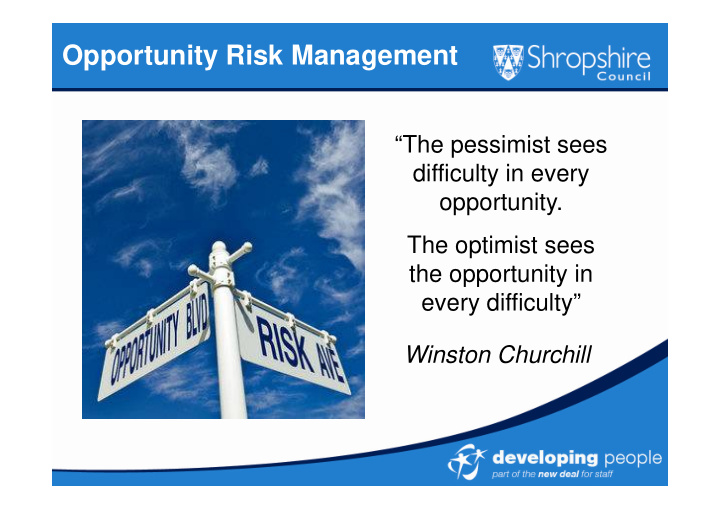



Opportunity Risk Management “The pessimist sees difficulty in every opportunity. The optimist sees the opportunity in every difficulty” Winston Churchill
The Risk Management Team Team Manager Angela Beechey (ALARM Risk Manager of the Risk Management Year 2010-11 ) Jane Cooper Lynne Hall Insurance Sara Done Samantha Fraser Tracy Read
Today’s Agenda • Introduction to Opportunity Risk Management • Shropshire Council’s Strategy for Managing Opportunity Risk • The Opportunity Risk Management Cycle
Opportunity Risk Management What is an Opportunity? • The possibility of doing something out of the ordinary, which has a welcome result. What is a Risk? • The threat that an event or action will adversely affect us achieving our opportunities and objectives. What is Opportunity Risk Management? • Realising our opportunities by managing the associated risks.
Opportunity Risk Management Strategy • Framework with six core principles • Risk appetite • Decide, Develop, Deliver Opportunity Risk Management Strategy • Maximising Opportunities • Reporting function • Governance • Roles and responsibilities • Training • Business continuity The possibility of doing something out of the ordinary, which has a welcome management result.
Why do we do it? • Greater certainty of delivery outcomes • Enhanced reputation • Confidence within communities • Improving the services we deliver • Developing close working relationships with our partners • Meeting internal/external audit requirements • Fulfilling contractual obligations • Compliance with data protection legislation • Maintaining quality of services
Our Priorities • Flourishing Shropshire Communities • Greater Public Confidence • Better Health & Wellbeing • Better Education Attainment and Work Placed Skills • Economic Growth & Prosperity • Modern Infrastructure & Different Ways of Working • Organisational Development & Behaviour Change
Lost at Sea Exercise
The Opportunity and Risk Management Cycle Identification The Opportunity Monitor and Assess and and Risk Review Prioritise Management Cycle Treat and Control
Analysis The Scoring Opportunities and Risks are scored in terms of likelihood and impact. Both are rated on a scale of one to five. The two scores are then multiplied to produce the overall opportunity or risk score and plotted on the matrices.
A Healthy Appetite Risk Tolerance 5 Level 4 Risks above this level Risk Acceptance 3 attract appropriate effort I Level and resources M P � 2 A C T 1 1 2 3 4 5 � LIKELIHOOD Risks below this level attract minimum effort and resources
Practical Exercise Part 1 Identify Opportunity Part 2 Associated Risks Part 3 Prioritise
Opportunity Matrix H H H H H 5 O H M M L L 4 P P I M M L L VL M 3 P A C T M L L VL VL 2 L L VL VL VL 1 5 4 3 2 1 OPPORTUNITY LIKELIHOOD
Risk Matrix H H H H H 5 R L L M M H I 4 S K I VL L L M M 3 M P A C VL VL L L M 2 T VL VL VL L L 1 1 2 3 4 5 RISK LIKELIHOOD
Monitoring and Review • Review, Re-assess, Report • Is the opportunity still viable and the risks still relevant? • Are the enablers to the opportunity being utilised and are the risk control measures and mitigation sufficient? • Are the scorings still accurate? • Have we identified the appropriate lead? • Are there any new opportunities or emerging risks?
Summing Up • Opportunity Risk management is vital to create a culture where good things happen • Controlling the associated risks must be realistic and proportionate • Document our opportunities and risks so we can ensure consistency and accountability Opportunity Risk Management never ends!
Intranet http://notes2/intranet/insurance.nsf
“The alternative to Risk Management is Crisis Management but that is far more expensive, embarrassing and time consuming” James Lam
Recommend
More recommend